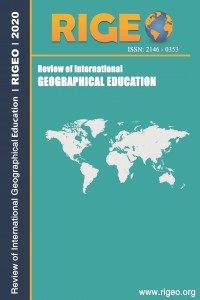Who is Listening to us from Geography Education? Is Anyone Out There?
Who is Listening to us from Geography Education? Is Anyone Out There?
This is the last of three studies designed to assess the interchange between the geography education
community, the larger geography field, and other disciplines. Our previous studies have examined
citation patterns between geography education journals and quantified whether a paradigm shift was
occurring from a focus on strategies and methods towards understanding the learning and teaching
process. Further, we wanted to know “who are we listening to?” The answer is that while we were
listening to ourselves (geography education), our scholars were incorporating knowledge, ideas, and
perspectives from the larger geography community and importantly from academicians and professionals
trained in pedagogy and education theories. This study asks the question, “who is listening to us?” Our
results indicate that education scholars are actually reading our publications. There were distinct lines of
communication between those from geography education and the disciplines of education that permeate
journals, books, conference proceedings, theses and dissertations, and other outlets (i.e. reports, blogs,
wikis).
___
- Albert, D. P. & Cassidy, E. (2017). To whom are we listening? Measuring the pulse of geography education research, 2010. Research in Geographic Education, 19 (1), 82-101.
- Albert, D. P, Gerrish, T. & Adu-Prah, S. (2017). A contemporary analysis of geography education journals. Papers in Applied Geography, 3 (1), 1-13.
- Alderman, D. (2017). Broadening and caring for the footprint of published scholarship. Retrieved on 7 February 2018 from http://news.aag.org/2017/12/broadening-and-caring-for-the- footprint-of-published-scholarship/
- Bednarz, S. (2000). Geography education research in the Journal of Geography 1988-1997. International Research in Geographical and Environmental Education, 9 (2), 128-140.
- Bednarz, R. S. & Bednarz, S. W. (2004). Geography education research in the Journal of Geography: The glass is half full and it’s getting fuller. The Professional Geographer, 56 (1), 128-140.
- Bodman, A. R. (2010). Measuring the influentialness of economic geographers during the ‘great half century’: An approach using the h index. Journal of Economic Geography, 10, 141- 156.
- Brunn, S. D. (2018). Citation impacts of AAG presidential addresses. The Professional Geographer, 70 (2), 209-218. Clarivate. (2017). Web of Science [Database]. Retrieved from http://webofknowledge.com/?DestApp=WOS
- Coomes, O. T., Moore, T., Paterson, J., Breau, S., Ross, N. A. & Roulet, N. (2013). Academic performance indicators for departments of geography in the United States and Canada. Professional Geographer, 65 (3), 433-450.
- Cynical Geographers Collective. (2011). Measuring impact beyond academic fame: An alternative social impact factor. Antipode, 43 (2), 190-194.
- Elsevier. (2017). Scopus [Database]. Retrieved from http://www.scopus.com
- Foster, J., Muellerleile, C., Olds, K. & Peck, J. (2007). Circulating economic geographies: Citation patterns and citation behaviour in economic geography, 1982–2006. Transactions of the Institute of British Geographers, 32 (3), 295-312.
- Gatrell, A. C., & Smith, A. (1984). Networks of relations among a set of geographical journals. Professional Geographer, 36 (3), 300-307.
- Google (2017). Google Scholar [Database]. Retrieved from https://scholar.google.com
- Harzing, A. W. (2007). Publish or perish. (Version 5). Retrieved from https://harzing.com/resources/publish-or-perish
- Johnston, R. (2003). Geography: A different sort of discipline? Transactions of the Institute of British Geographers, 28 (2), 133-141.
- Journal of Geography in Higher Education. (2010). Taylor & Francis Online. Retrieved December 30, 2016, from http://www.tandfonline.com/loi/cjgh20
- Lawrence, S. (2001). Free online availability increase a paper’s impact. Nature, 411, 521.
- Liu, Z. (2007). Scholarly communication in educational psychology: A journal citation analysis. Collection Building, 26(4), 112-118.
- Liu, Z. & Wang, C. (2005). Mapping interdisciplinarity in demography: A journal network analysis. Journal of Information Science, 31 (4), 308-316.
- National Center for Research in Geography Education. (2017). Powerful geography: New thinking for the next generation of geography education. Retrieved from http://powerfulgeography.org/
- Persson, O. & Ellegård, K. (2012). Torsten Hägerstrand in the citation time web. Professional Geographer, 64 (2), 250-261.
- SCImago. (2007-2016). SJR — SCImago Journal & Country Rank. Retrieved 23 December 23 2016, from http://www.SCImagojr.com
- Solomon, G. E. A., Carley, S. & Porter, A. L. (2016). How multidisciplinary are the multidisciplinary journals Science and Nature? PLoS ONE, 11 (4), e0152637. doi:10.1371/journal.pone.0152637.
- Tan, L. (2016). Environmental Education that Matters, IGU-CGE Singapore Conference 2016, 14 – 16 August, Singapore. Retrieved from http://files.seaga.webnode.com/200000385- f1b65f2b0a /Final%20Programme%2011%20Aug%202016%20-for%20website.pdf
- The American Assembly. (2017). The Open Syllabus Project. Retrieved from https://opensyllabusproject.org/
- Turner, B. L. & Meyer, W. B. (1985). The use of citation indices in comparing geography programs: An exploratory study. Professional Geographer, 37 (3), 271-278.
- Weingart, P. (2005). Impact of bibliometrics upon the science system: Inadvertent consequences? Scientometrics, 62 (1), 117-131.
- Wrigley, N. & Matthews, S. (1986). Citation classics and citation levels in geography. Area, 18 (3), 185–194.
- Wrigley, N. & Overman, H. (2010). Editorial: The 10th year of the Journal of Economic Geography. A decade of high impact publication. Journal of Economic Geography, 10: 1– 8.
- Zawacki-Richter, O. & Anderson, T. (2011). The geography of distance education – Bibliographic characteristics of a journal network. Distance Education, 32 (3), 441-456.
- Zygomatic (2017). WordClouds.com. Retrieved from https://www.wordclouds.com/
- ISSN: 2146-0353
- Başlangıç: 2011
- Yayıncı: Eyüp ARTVİNLİ
Sayıdaki Diğer Makaleler
Examination of Main Trends in Geographical Education Research in Turkey
Reflections of Environmental Determinism in the Questions Prepared by Geography Teacher Candidates
Who is Listening to us from Geography Education? Is Anyone Out There?
Donald Patrick ALBERT, Erin OWENS
“This question is too personal!” Guided Inquiry as Part of Teaching Human Geography Research Methods
Günther WEISS, Elisabeth GOHRBANDT
Relationship between Geography-Tourism and Tourism's Effects According to High School Students
